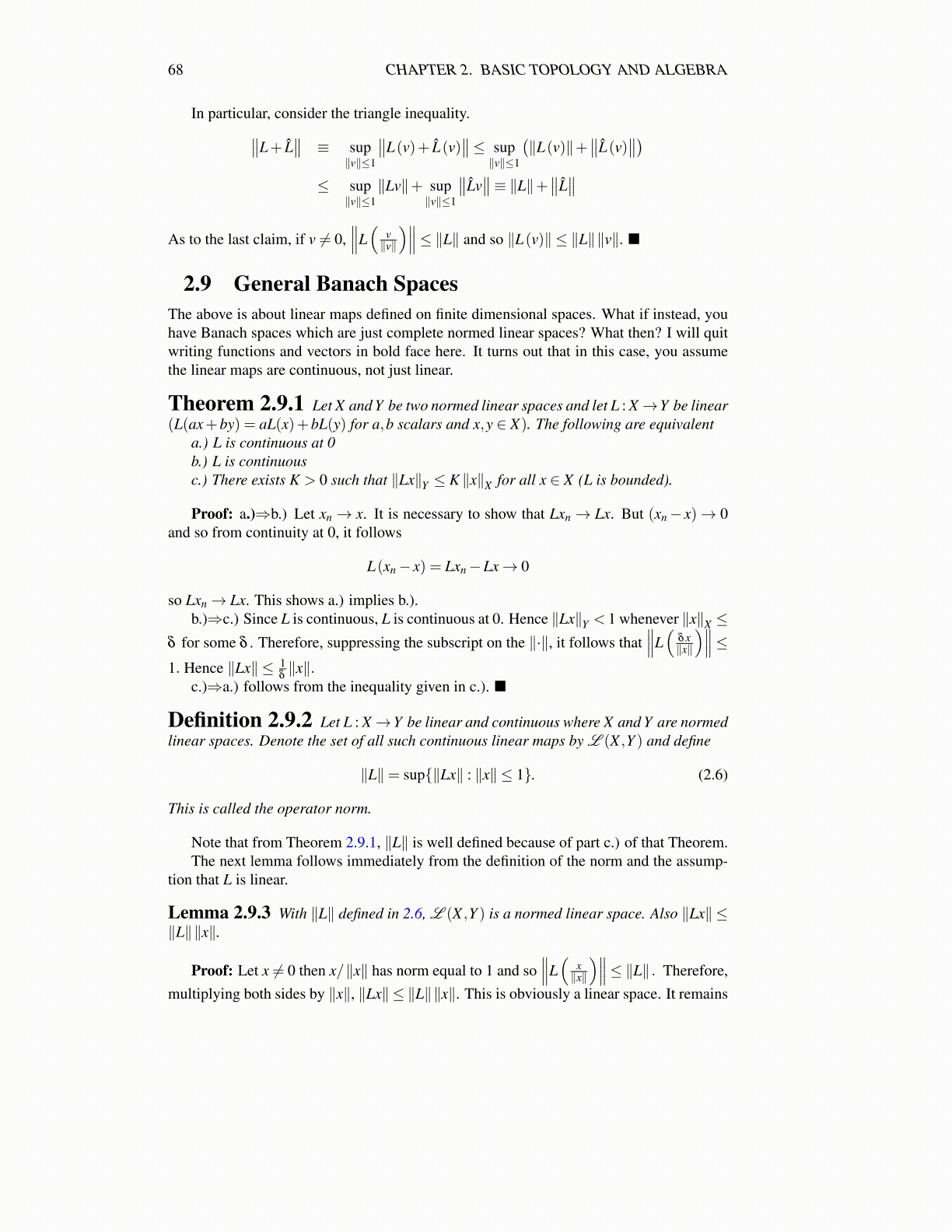
68 CHAPTER 2. BASIC TOPOLOGY AND ALGEBRA
In particular, consider the triangle inequality.∥∥L+ L̂∥∥ ≡ sup
∥v∥≤1
∥∥L(v)+ L̂(v)∥∥≤ sup
∥v∥≤1
(∥L(v)∥+
∥∥L̂(v)∥∥)
≤ sup∥v∥≤1
∥Lv∥+ sup∥v∥≤1
∥∥L̂v∥∥≡ ∥L∥+∥∥L̂
∥∥As to the last claim, if v ̸= 0,
∥∥∥L(
v∥v∥
)∥∥∥≤ ∥L∥ and so ∥L(v)∥ ≤ ∥L∥∥v∥. ■
2.9 General Banach SpacesThe above is about linear maps defined on finite dimensional spaces. What if instead, youhave Banach spaces which are just complete normed linear spaces? What then? I will quitwriting functions and vectors in bold face here. It turns out that in this case, you assumethe linear maps are continuous, not just linear.
Theorem 2.9.1 Let X and Y be two normed linear spaces and let L : X→Y be linear(L(ax+by) = aL(x)+bL(y) for a,b scalars and x,y ∈ X). The following are equivalent
a.) L is continuous at 0b.) L is continuousc.) There exists K > 0 such that ∥Lx∥Y ≤ K ∥x∥X for all x ∈ X (L is bounded).
Proof: a.)⇒b.) Let xn → x. It is necessary to show that Lxn → Lx. But (xn− x)→ 0and so from continuity at 0, it follows
L(xn− x) = Lxn−Lx→ 0
so Lxn→ Lx. This shows a.) implies b.).b.)⇒c.) Since L is continuous, L is continuous at 0. Hence ∥Lx∥Y < 1 whenever ∥x∥X ≤
δ for some δ . Therefore, suppressing the subscript on the ∥·∥, it follows that∥∥∥L(
δx∥x∥
)∥∥∥≤1. Hence ∥Lx∥ ≤ 1
δ∥x∥.
c.)⇒a.) follows from the inequality given in c.). ■
Definition 2.9.2 Let L : X→Y be linear and continuous where X and Y are normedlinear spaces. Denote the set of all such continuous linear maps by L (X ,Y ) and define
∥L∥= sup{∥Lx∥ : ∥x∥ ≤ 1}. (2.6)
This is called the operator norm.
Note that from Theorem 2.9.1, ∥L∥ is well defined because of part c.) of that Theorem.The next lemma follows immediately from the definition of the norm and the assump-
tion that L is linear.
Lemma 2.9.3 With ∥L∥ defined in 2.6, L (X ,Y ) is a normed linear space. Also ∥Lx∥ ≤∥L∥∥x∥.
Proof: Let x ̸= 0 then x/∥x∥ has norm equal to 1 and so∥∥∥L(
x∥x∥
)∥∥∥≤ ∥L∥ . Therefore,multiplying both sides by ∥x∥, ∥Lx∥ ≤ ∥L∥∥x∥. This is obviously a linear space. It remains